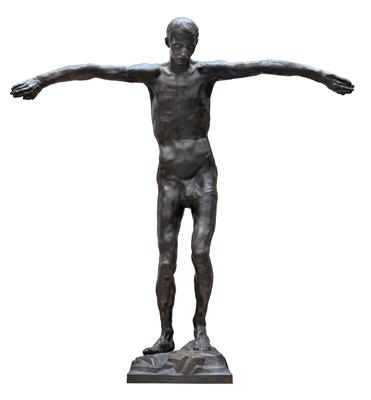Anton Hanak

(Brno 1875–1934 Vienna)
‘Der letzte Mensch’, also referred to by Hanak as ‘Ecce Homo’, posthumous impression of the version preserved in the Österreichische Galerie Belvedere, dark patinated bronze, inscribed in the plinth ‘Ecce Homo’. Anton Hanak 1917–24. Gegossen Erzgiesserei AG unter Pfeffer sowie Giesserei Beck 1986, one out of three casts, height approx. 233 cm (including stand), (K)
Compare:
Hedwig Steiner, Anton Hanak, Werk, Mensch und Leben, Rosenheim, Delp’sche Verlagsbuchhandlung, Munich, 1969, fig. 33, p. XXVII, no. 51 Friedrich Grassegger/Wolfgang Krug, Anton Hanak, 1875–1934, Böhlau Verlag, 1997, pp. 149–157
Provenance:
Austrian Private Collection
’And when we pause and our eyes have been freed from blindness, we see the image that is actually most familiar to us, but which has almost been erased by the war. Behold the Man! […] Without something to hold on to above and below, entirely impotent, he has been deserted by everything that once surrounded him. Mankind has forgotten about Man‘
Anton Hanak, ‘Ich über mich’, lecture held at the Vienna Urania in 1925, quoted from the transcript at the Hanak Archives.
The first version, which was exhibited in 1917 in Munich, Stockholm, and Copenhagen and which still showed the ‘Last Man’ completely in the nude, was reworked by Anton Hanak over the years in at least six further variants. The most conspicuous changes included the addition and varied arrangements of drapery covering the private parts, the position of the legs, the volume of the upper body, and the form of the stand. ‘This is how the ‘Last Man’ came into being from 1914 on – initially in its first version, and then, after years of tireless work, in its final form, to be used for the bronze cast. Even in terms of material, this work stands out from all the others, having the smallest mass of all. And it is entirely in the sense of the artist to say that this unusual removal of mass virtually caused him continuous physical pain.
In many contemporary accounts about Hanak’s ‘Last Man’, reference is made time and again to its realisation as a direct response to the World War…’
Wolfgang Krug, ‘Die modernen Niobiden’, quoted from the aforementioned literature.
Specialist: Mag. Elke Königseder
 Mag. Elke Königseder
Mag. Elke Königseder
+43-1-515 60-358
elke.koenigseder@dorotheum.at
25.11.2014 - 18:00
- Estimate:
-
EUR 35,000.- to EUR 45,000.-
Anton Hanak
(Brno 1875–1934 Vienna)
‘Der letzte Mensch’, also referred to by Hanak as ‘Ecce Homo’, posthumous impression of the version preserved in the Österreichische Galerie Belvedere, dark patinated bronze, inscribed in the plinth ‘Ecce Homo’. Anton Hanak 1917–24. Gegossen Erzgiesserei AG unter Pfeffer sowie Giesserei Beck 1986, one out of three casts, height approx. 233 cm (including stand), (K)
Compare:
Hedwig Steiner, Anton Hanak, Werk, Mensch und Leben, Rosenheim, Delp’sche Verlagsbuchhandlung, Munich, 1969, fig. 33, p. XXVII, no. 51 Friedrich Grassegger/Wolfgang Krug, Anton Hanak, 1875–1934, Böhlau Verlag, 1997, pp. 149–157
Provenance:
Austrian Private Collection
’And when we pause and our eyes have been freed from blindness, we see the image that is actually most familiar to us, but which has almost been erased by the war. Behold the Man! […] Without something to hold on to above and below, entirely impotent, he has been deserted by everything that once surrounded him. Mankind has forgotten about Man‘
Anton Hanak, ‘Ich über mich’, lecture held at the Vienna Urania in 1925, quoted from the transcript at the Hanak Archives.
The first version, which was exhibited in 1917 in Munich, Stockholm, and Copenhagen and which still showed the ‘Last Man’ completely in the nude, was reworked by Anton Hanak over the years in at least six further variants. The most conspicuous changes included the addition and varied arrangements of drapery covering the private parts, the position of the legs, the volume of the upper body, and the form of the stand. ‘This is how the ‘Last Man’ came into being from 1914 on – initially in its first version, and then, after years of tireless work, in its final form, to be used for the bronze cast. Even in terms of material, this work stands out from all the others, having the smallest mass of all. And it is entirely in the sense of the artist to say that this unusual removal of mass virtually caused him continuous physical pain.
In many contemporary accounts about Hanak’s ‘Last Man’, reference is made time and again to its realisation as a direct response to the World War…’
Wolfgang Krug, ‘Die modernen Niobiden’, quoted from the aforementioned literature.
Specialist: Mag. Elke Königseder
 Mag. Elke Königseder
Mag. Elke Königseder
+43-1-515 60-358
elke.koenigseder@dorotheum.at
|
Buyers hotline
Mon.-Fri.: 10.00am - 5.00pm
kundendienst@dorotheum.at +43 1 515 60 200 |
| Auction: | Modern Art |
| Auction type: | Saleroom auction |
| Date: | 25.11.2014 - 18:00 |
| Location: | Vienna | Palais Dorotheum |
| Exhibition: | 15.11. - 25.11.2014 |
